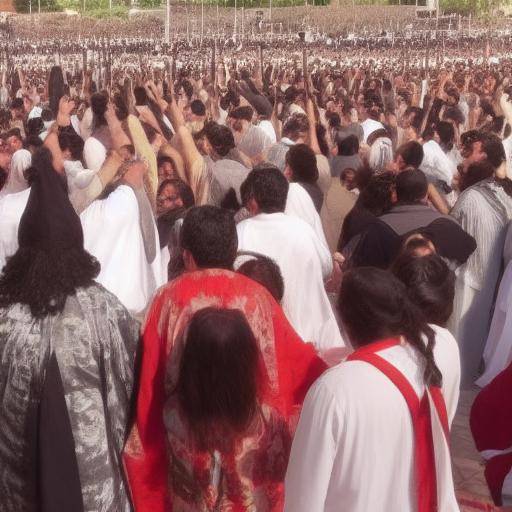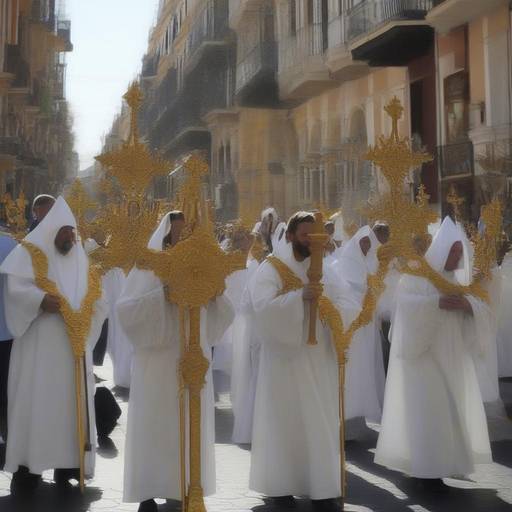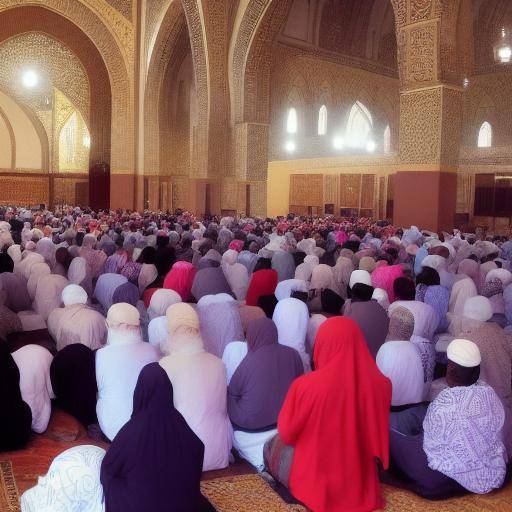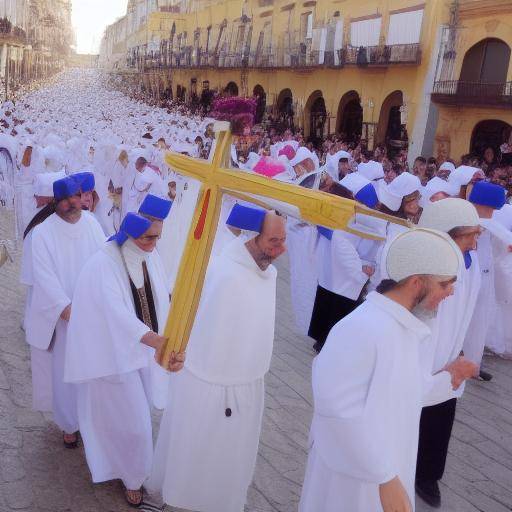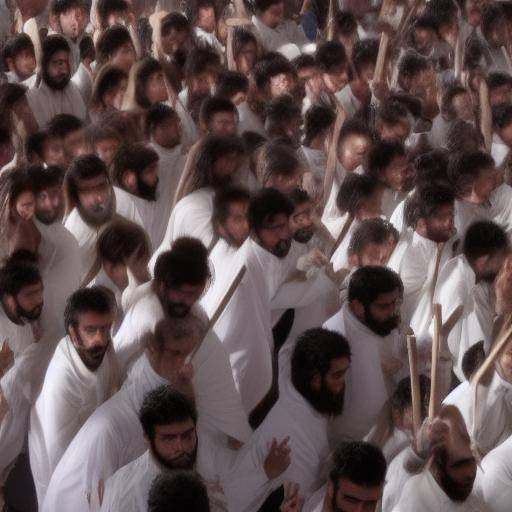
The Ashura is a celebration of great importance for the Shiite Muslim community commemorating the martyrdom of the grandson of the Prophet Muhammad, the Imam Husayn, in the 61st year of the Hegira. This event acquires a profound spiritual and social relevance for the Shiite faithful, who carry out processions and acts of mourning as an act of penance and solidarity.
In this article, we will explore the history, meaning and practices associated with the Ashura, as well as its relevance in the context of Islamic culture. In addition, we will examine in detail the martyrdom in the Islamic tradition, as well as the processions that characterize this commemoration. We will deepen the importance of the Ashura, its impact on the Shiite community, and the rituals associated with this celebration.
Introduction
The Importance of the Ashura in the Shiite Tradition
Ashura is an event of great spiritual and emotional weight within Shiite Islam, marked by acts of penance, mourning and devotion. This day commemorates the martyrdom of the imam Husayn, grandson of the Prophet Muhammad, in the Battle of Karbala in the 61st year of the Hegira. For Shia, Husayn's sacrifice symbolizes the struggle for justice and resistance to oppression, being a key event in the religious and social identity of this community.
Throughout the centuries, the Ashura has acquired a relevance not only spiritual, but also cultural and social, being a symbol of resistance, struggle for justice and solidarity. The Ashura commemorations include rituals of penance, processions, readings of stories about the martyrdom of Husayn, and manifestations of mourning that aim to honor the memory of the magnet and relive its sacrifice as a sign of faith and devotion.
History and Context of the Ashura
Origins and Evolution of the Ashura
The Ashura has its roots in the martyrdom of the imam Husayn, son of Ali (the first and son-in-law of Mohammed) and Fatima (the daughter of Mohammed), at the hands of the army of the Omeya Caliph Yazid I in the Battle of Karbala in 680. The sacrifice of Husayn and his followers in the battle became a momentous event in the history of Shiite Islam, being celebrated and commemorated from generation to generation.
The first accounts on the commemoration of the Ashura date back to the X century and show the growing importance of this event in Shiite religious practice. Over the centuries, this celebration has evolved, adopting different manifestations, rituals and practices in different Shiite communities around the world.
Ritual of Ashura and Religious Practices
During the day of Ashura, the Shiite faithful participate in rituals that include fasting, prayer, reciting stories about the martyrdom of Husaynan, and processions in which the suffering and sacrifice of the magnet and his followers are remembered. This day is also a space for reflection, solidarity and the search for redemption, in which the faithful join in acts of penance and solidarity in honor of Husayn and in resistance against injustice.
Detailed Analysis
The Meaning of martyrdom in Islamic Tradition
martyrdom has a profound meaning in the Islamic tradition, being regarded as an act of supreme sacrifice in defense of faith and the principles of justice. In Islamic conception, martyrdom is not only a testimony of courage and loyalty, but also a means of reaching closeness to God and exerting a powerful influence on the community, inspiring moral values and principles.
The martyrdom of Husayn became a symbol of resistance and courage in the struggle against injustice, and its annual commemoration is a reminder of the sacrifice that reminds the Shiite faithful of the commitment to the fundamental values of Islam and the struggle against oppression.
Processions as Devotion Manifestation
The processions during the Ashura are a visual and emotional manifestation of the devotion and mourning of the Shiite faithful. These processions tend to have participants who flounder as a sign of penance and devotion, or walk through the streets in groups, chanting chants and laments in honor of Husayn. Processions are a symbol of solidarity and community, where participants express their pain for the martyrdom of Husayn and reaffirm their commitment to the ideals of justice and resistance.
Exhaustive examination
The Influence of the Ashura in the Shiite Community
The Ashura exerts a significant influence on the Shiite community, strengthening the bonds of solidarity and devotion among the faithful. Through the commemorations, the Shiites honor the legacy of Husayn as a symbol of courage and resistance to oppression, seeking to inspire and strengthen their commitment to the fundamental values of Islam. This event is an annual reminder of the principles of justice, honour and loyalty, which are deeply rooted in the religious and social identity of the Shiite community.
Current Challenges and Reflections
Despite its profound spiritual significance, the Ashura also faces challenges today. The way some communities perform certain rituals, such as self-flageting, has generated controversy in some contexts, challenging the interpretation and practice of the rituals associated with the Ashura. This debate reflects the diversity of approaches within the Shiite community and raises questions about the relevance and adaptation of traditional practices in contemporary society.
Comparative analysis
Parallel and Differences between Islam, Martyrdom and Processions
Islam as a whole values martyrdom as a demonstration of courage and loyalty to the fundamental principles of faith, although interpretations and practices vary among the different branches of Islam. The concept of martyrdom and its meaning in Shiite tradition is distinguished by its emphasis on resistance and the struggle against oppression, while the processions during the Ashura show a unique expression of devotion and mourning within the Shiite community.
In addition, the processions during the Ashura can find parallels in other religious celebrations, such as the manifestations of penance in other religious traditions, although the history and symbolism associated with the Ashura give it a unique identity within the Shiite Islam.
Practical Tips and Recommendations
Personal Reflection and Community Participation
For those interested in better understanding the meaning of Ashura, personal reflection is recommended on the meaning of martyrdom, resistance and justice in Shiite Islam. Participation in the Ashura commemorations, if welcome and respectful, can provide a unique experience of solidarity and devotion that allows us to better understand the importance and impact of this celebration in the Shiite community.
Conclusions and FAQs
Conclusions
The Ashura represents an event of great spiritual, social and cultural significance for the Shiite community, in which the rituals of penance, processions and mourning are profound manifestations of devotion and solidarity. Through their commemoration, the Shiite faithful renew their commitment to the fundamental values of Islam, strengthening community ties and reaffirming their religious identity.
Frequently asked questions
What is the importance of the Ashura within Shiite Islam?
Ashura is a central event in the Shiite tradition, commemorating the martyrdom of the Imam Husayn and symbolizing the struggle for justice, resistance to oppression and solidarity.
What does martyrdom mean in Islam?
martyrdom in Islam is considered an act of supreme sacrifice in defense of faith and the principles of justice. It represents a testimony of loyalty and courage, as well as a means of reaching closeness to God and exerting a powerful influence on the community.
How are the processions carried out during the Ashura?
The processions during the Ashura are visual and emotional manifestations of devotion and mourning, in which the participants travel through the streets intoning chants and laments in honor of Husayn. Some participants are scourged as a sign of penance and devotion.
What is the role of the Ashura in the current Shiite community?
The Ashura exerts a significant influence on the Shiite community, strengthening the bonds of solidarity and devotion among the faithful. It is an annual reminder of the principles of justice, honour and loyalty, which resonate deeply in the religious and social identity of the Shiite community.
In what contexts is the Ashura commemorated?
The Ashura is commemorated by Shiite communities around the world and is an event of great importance in the Shiite religious calendar. The commemorations may vary in detail and specific practices from one region to another.
What is the relevance of the Ashura for Shiite Muslims today?
The Ashura remains a manifestation of devotion, solidarity and resistance for Shiite Muslims today. Through the commemoration of the martyrdom of Husayn, the faithful renew their commitment to the fundamental values of Islam and strengthen their religious and community identity.
How can you better understand the meaning of the Ashura?
Personal reflection on the meaning of martyrdom, resistance and justice in the context of the Ashura can help to better understand its spiritual and cultural importance. Respectful participation in commemorations can also provide a unique experience of solidarity and devotion.
In conclusion, the Ashura is a celebration of profound significance for the Shiite Muslim community, which commemorates the martyrdom of the imam Husayn and represents a symbol of resistance, justice and solidarity. Through its rituals of penance, processions and manifestations of mourning, Ashura strengthens community ties and renews commitment to the fundamental values of Islam.

